Device filters
PERMISSIONS Refer to Global > Filters and Sites > Filters in Permissions.
NAVIGATION Filters and Groups > Filters
NAVIGATION Global > Filters
NAVIGATION Sites > All Sites > click the name of a site > Filters (left navigation menu)
NAVIGATION Devices > All > Filters & Groups
About filters
A filter in Datto RMM is a tool that is used to sort through a large number of devices. Filters rely on device audit data and can be configured with certain criteria to target specific attributes of a device.
Filters are dynamic and work independently of sites, so you can have a filter that looks for devices with specific criteria across all sites. As device attributes change, filters are automatically updated and all devices that match the filter criteria will be displayed in the filter results. Filters are a critical part of Datto RMM, as they can effectively target the right devices with reports, monitors, jobs, patch management, etc. If your servers go offline, for example, you can target an online status monitor at your servers with the help of a filter.
Default Device Filters
A set of Default Device Filters is available in Datto RMM. Refer to Using Default Device Filters.
Custom Device Filters
A Custom Device Filter is a custom filter that can be applied globally to all sites. You can choose for these types of filters to contain devices from every site or from selected sites only.
Site Device Filters
A Site Device Filter is a custom filter that can be applied at the site level. You can choose for these types of filters to be available in all of your current and future sites or in one target site.
IMPORTANT The device filter type (Scope) cannot be edited after initially saving a custom filter.
Creating a filter
To create a filter, follow any of the first three navigation paths described in Security and navigation and click Create Filter.
Enter a name for the filter.
Select Global to create a Custom Device Filter or Site to create a Site Device Filter. Refer to Device filter types.
If Site is selected, you can add this filter to other sites within your account and to future sites by turning on the Add Filter to all Sites toggle. Selecting this option produces the following results:
- The user who creates the filter is opting to make the filter available in all the sites their assigned security level currently has access to. Refer to Device visibility in Security levels or Security Levels in Creating or editing a site.
- The filter will be automatically available in any sites the user creates in the future.
- The availability of this filter to other users depends on whether or not the creator chooses to share the filter with other security levels (the last step on the filter creation page) as well as users' access to sites according to their security levels. For instructions, refer to the Security Levels section in this topic.
EXAMPLE User 1 is assigned to Security Level A, while User 2 is assigned to Security Level B.
User 1 creates a Site Device Filter for Site X, turns on the Add Filter to all Sites toggle, and shares the filter with Security Level B.
This filter will be available to User 2 only in sites that both Security Level A and Security Level B have access to. For example, if User 1 has access to Sites X, Y, and Z and User 2 has access to Sites W, X, and Y, then when the filter is shared by User 1, User 2 will see the filter only in Sites X and Y.
If the Add Filter to all Sites option is disabled, you can enter a site name in the Target Site field. The search results will be narrowed as you type.
Use the drop-down menus to select the criteria you want to filter on. You can specify more than one criterion in the filter by clicking the plus icon either at the end of the row or underneath a row.
Certain symbols function as wildcards for any characters in filter criteria. Refer to Filter criteria wildcard characters.
For a complete list of filter criteria, refer to Filter criteria definitions.
NOTE When you add additional criteria, you cannot combine AND and OR. The selection you made first is repeated for any subsequent criterion.
Specify criteria as follows:
- Select a term.
- Select a restriction.
- Click the plus icon below the specified criterion.
- Select the OR or AND operator.
NOTE If both conditions must be true for a device to be included in the search results, select AND. If either one must be true, select OR.
- Click the plus icon to add another criterion or the minus icon to remove any of the criteria.
Group queries with a criterion as follows:
- Click the plus icon next to a criterion.
- Select the OR or AND operator.
EXAMPLE Positive criterion queries (for example, Software package contains 1, Software package contains 2, Software package contains 3) must be grouped with OR. For example, Software package contains Adobe Reader OR Foxit Reader OR Sumatra PDF will return devices that have either Adobe Reader or Foxit Reader or Sumatra PDF installed.
EXAMPLE
Negative criterion queries (for example, Software package does not contain 1, Software package does not contain 2, Software package does not contain 3) need to be grouped with AND. For example, Software package does not contain Adobe Reader AND Foxit Reader AND Sumatra PDF will only return devices that have neither Adobe Reader nor Foxit Reader or Sumatra PDF installed.
- Select the next criterion or click the minus icon to remove any of the criteria from the group.
A note on the "does not contain" criterion
NOTE When using the does not contain criterion, the is empty criterion is implicitly included.
NOTE When filtering for Patch Title (Installed) and using the does not contain criterion, devices with 0 installed patches are excluded from the filter results.
The following table illustrates a difference in how empty fields are handled in custom filters:
| Criterion | Does it include the "is empty" criterion? |
|---|---|
| Does not contain | Yes |
| Does not equal | No |
| Does not begin with | No |
| Does not end with | No |
EXAMPLE For instance, if User-Defined Field 1 is empty for a device, that device will show up in a filter for User-Defined Field 1 does not contain XYZ but will not show up in a filter for User-Defined Field 1 does not equal XYZ.
The is empty criterion can be added to any of the above criteria using OR.
EXAMPLE In the above example, the is empty criterion could be included along with does not equal by adding another criterion of OR User-Defined Field 1 is empty.
This option is available only if Global is selected in Scope.
Turn on the Select devices from all sites toggle to target all devices in all sites, including any sites created in the future.
If you choose to target specific sites, click Add Target. From within the pane that opens, click Add or Delete for each site you wish to include or exclude. When you are finished, click X to close the pane.
To exclude a site, you can also click the delete icon ![]() to the site name.
to the site name. 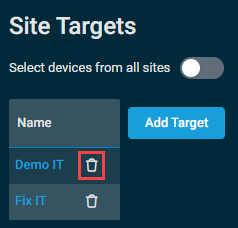
By default, only the filter creator can view, edit, and delete the filter. However, you can specify whether you want to share the filter with other security levels within the account by turning on the Share filter with users from other security levels toggle.
NOTE The users with whom you shared the filter will be able to open the filter shared with them, see the criteria it uses, and view the results of the filter. They will also be able to edit or delete the filter if they have Manage permissions for Filters. Refer to Permissions.
A user assigned to a security level to which the filter is shared will see the new filter in the site the filter was created for, as long as the security level has access to the site. Refer to Device visibility in Security levels or Security Levels in Creating or editing a site.
EXAMPLE User 1 is assigned to Security Level A, while User 2 is assigned to Security Level B.
User 1 creates a Site Device Filter for Site X. Refer to Scope in this topic. User 1 shares the filter with Security Level B. However, Security Level B does not have access to Site X. Therefore, this filter won't be available to User 2 when they are logged in to their account using Security Level B.
If Site X is later made accessible to Security Level B, then User 2 will see both Site X and this filter.
NOTE When a user creates a new site, that site will not automatically inherit all the filters that were set to be shared with the site creator's assigned security level (neither previously assigned nor currently assigned).
If the Share filter with users from other security levels option is enabled, click Add Security Level. Refer to Security levels. From within the pane that opens, click Select or Deselect for each security level you wish to include or exclude. When you are finished, click X to close the pane.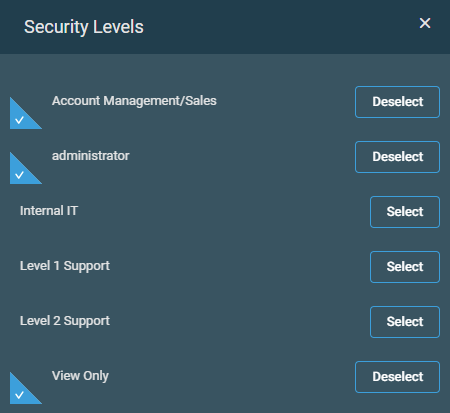
NOTE For administrator users, all security levels are visible, including the Administrator security level. For non-administrator users, the Administrator security level as well as the security levels they have access to are visible. Refer to Security Levels in Users.
To remove access to this filter for a security level, you can also click the delete icon ![]() next to the security level. Removing a security level from this list will not delete the security level itself.
next to the security level. Removing a security level from this list will not delete the security level itself.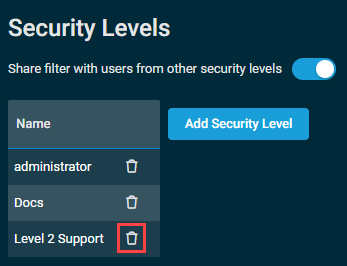
When you are finished, click Save to create the filter or Cancel to discard the new filter progress and return to the Device Filters page.
NOTE The Name field is required for the Save button to become available.
A dialog box will confirm whether you wish to create this filter. Click Confirm to execute the action or Cancel to close out of the dialog box. A confirmation dialog box will confirm that the filter has been created successfully.
Viewing and managing filters
Navigate to a Device Filters page by following any of the first three navigation paths described in Security and navigation.
Viewing filters at global and site levels
From the left navigation menu, click either Global > Filters or Filters and Groups > Filters to see all device filters. At the top of the page, click Global Default, Global Custom, or Site Custom to filter the list by the respective type.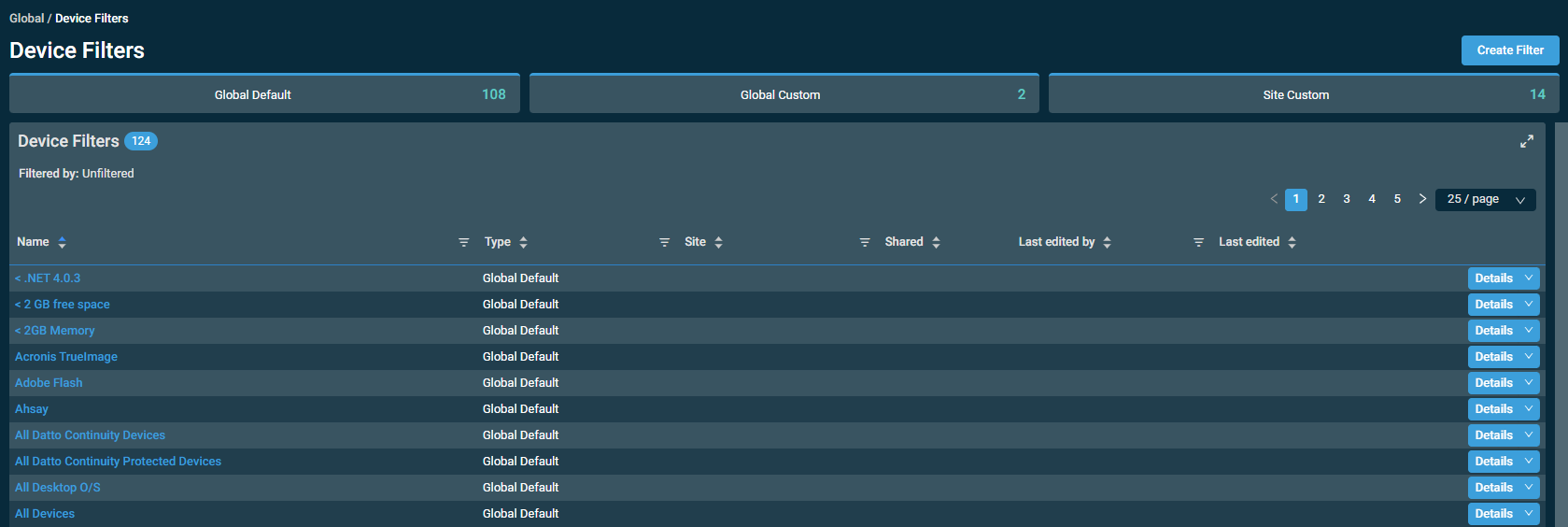
To see a list of Site Device Filters that apply to only one site, enter a site name in the Site column filter. Alternatively, from the left navigation menu, click Sites > All Sites > click the name of a site > Filters.
The table displays the following information:
| Field | Sortable? | Description |
|---|---|---|
| Name |
|
The name of the device filter. Click the link to go to the list of the devices targeted by this filter. Refer to View Devices. To narrow the list, click the filter icon |
| Type |
|
Displays the device filter type, which can be one of the following:
To narrow the list, click the filter icon |
| Site |
|
For Site Device Filters, displays the name of the site this device filter is targeting. Click the link to go to the site's site summary page. Refer to Site summary. To search for a particular site, click the filter icon |
| Shared |
|
For Custom Device Filters or Site Device Filters, displays a count of how many security levels this device filter is shared with. |
| Last Edited By |
|
The name of the user who last modified this device filter. To search for a particular user, click the filter icon |
| Last Edited |
|
Displays when the device filter was last edited. |
You can filter any columns with the filter icon ![]() . The Filtered by bar displays all applied column filters. If a filter search term includes wildcard characters (for example, underscores and percent signs), they serve as normal characters if they are preceded by a backslash. For details, refer to Wildcard characters. Click the X next to any filter to remove that filter or click Reset Filters to remove all filters. If no filter is applied, the Filtered by bar displays Unfiltered. The filter selection will not persist the next time the page is accessed as the table will return to the default view (unfiltered).
. The Filtered by bar displays all applied column filters. If a filter search term includes wildcard characters (for example, underscores and percent signs), they serve as normal characters if they are preceded by a backslash. For details, refer to Wildcard characters. Click the X next to any filter to remove that filter or click Reset Filters to remove all filters. If no filter is applied, the Filtered by bar displays Unfiltered. The filter selection will not persist the next time the page is accessed as the table will return to the default view (unfiltered).
The table density is set to condensed theme by default. To change it to relaxed theme, click the density toggle icon. ![]() The selection will persist across all pages.
The selection will persist across all pages.
The number of results displayed can be specified by selecting the desired number from the pagination control. This selection will persist the next time the page is accessed.
From the list of device filters, you can open a pane that displays all details of a certain filter. Click the Details button for any filter in the list. The pane will open on the right side of the page.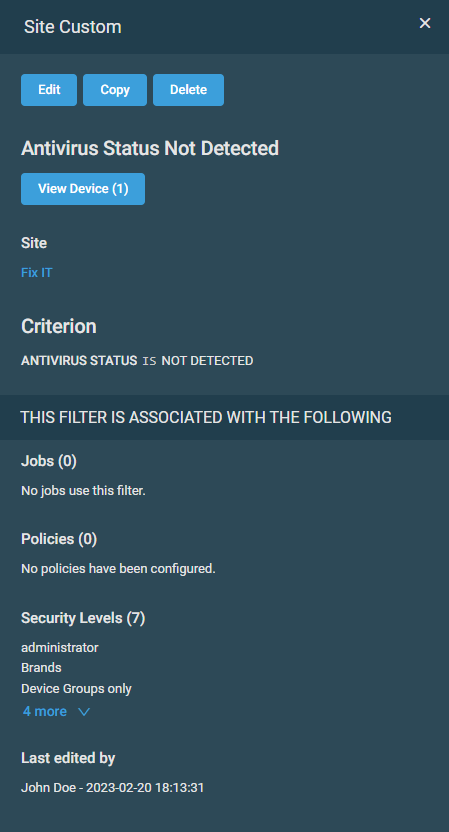
| Field | Description |
|---|---|
| [Filter Type] | The type of device filter is shown at the top of the pane. Refer to Device filter types. |
| Edit | Refer to Editing or deleting a filter. |
| Copy | Refer to Copying a filter. |
| Delete | Refer to Editing or deleting a filter. |
| [Name] | The name of the device filter. |
View Devices |
Click this button to close the pane and view the list of the devices targeted by this filter. Refer to Devices. Another way to open this list is by clicking the name of a filter in the list of filters. Refer to Name in List of filters. NOTE If there are no matching devices or you do not have permission to access these devices, the View Devices button will not be available. NOTE If no results are returned within 30 seconds, the View Devices button will not be available and an error message will be displayed. The table density is set to condensed theme by default. To change it to relaxed theme, click the density toggle icon. The refresh icon NOTE Column filtering is not available in this table. The Column Chooser icon The number of results displayed can be specified by selecting the desired number from the pagination control. This selection will persist the next time the page is accessed. Action buttonsClick View Filter to open the pane of filter details on the right side of the page. Refer to Action buttons in Devices for information about the rest of the actions available from within this table. |
| Site | For Site Device Filters, the name of the site this device filter is targeting. Click the link to go to the site's site summary page. Refer to Site summary. |
| Criterion | The device attributes this filter is targeting. Refer to Criteria. |
| Jobs | The number of jobs that are associated with this device filter and a list of the jobs. For longer lists, click the more link to expand the list. Click Show Less to collapse the list. |
| Policies | The number of policies that are associated with this device filter and a list of the policies. For longer lists, click the more link to expand the list. Click Show Less to collapse the list. |
| Site Targets | Indicates whether this filter targets all sites or specific sites. If specific sites are targeted, the list of sites is displayed. For longer lists, click the more link to expand the list. Click Show Less to collapse the list. |
| Security Levels | For Custom Device Filters or Site Device Filters, the number of security levels that this device filter is shared with and a list of the security levels sorted alphabetically. For longer lists, click the more link to expand the list. Click Show Less to collapse the list. |
| Last Edited By | The user who last modified this device filter, as well as when the filter was last edited. |
Custom Device Filters and Site Device Filters can be modified from the pane or by clicking the drop-down arrow next to the Details button in the last column in the table. You can edit or delete a custom filter as follows:
- To update filter details, click Edit. Refer to Creating a filter.
NOTE The scope of the filter (Global or Site) is not editable. For Site Device Filters only, select Yes or No. In addition, the target site is not editable. Refer to Scope.
NOTE A Target Site can be modified for Custom Device Filters only. Refer to Site Targets.
- To delete the custom filter, click Delete. Note that anything currently associated will be affected.
In the confirmation dialog box that appears, select the I understand that this action is irreversible check box to confirm the action.
Click Delete to execute the action or Cancel to close out of the dialog box.
Filters of any type can be copied from the pane or by clicking the drop-down arrow next to the Details button in the last column in the table. Click Copy in either location.
NOTE If you copy a Default Device Filter (Global Default type), the copy will be saved as a Custom Device Filter (Global Custom type).
The copy will be named Copy of [existing filter name] by default. The copy will be automatically configured with the same scope, criteria, site targets, and security levels as the original filter. You can modify these details as necessary and click Save to create the copy. Refer to Creating a filter.
Using Default Device Filters
Up-to-date Default Device Filter definitions are available directly within the web interface. Navigate to the Criterion section in the detail pane for any filter. Refer to Viewing filter details.
Default Device Filters are available by default and cannot be edited or deleted. You can use them in the same way as Custom Device Filters and Site Device Filters to filter devices across all your sites or in one particular site. Default Device Filters are also localized if the language of the UI is changed. Refer to Languages and User Language.
NOTE If a dashboard widget is created using a Default Device Filter, the name of the widget will appear in the language that was configured when the widget was created, even if the language is subsequently changed. To change the name, you must manually edit it within the dashboard. Refer to Device Filter.
To view a list of the Default Device Filters applied globally, select Global Default from the Type column filter.
To view a specific filter definition and all of the devices associated with the filter, click the filter name to open a pane to the right. Click X to close the pane.



